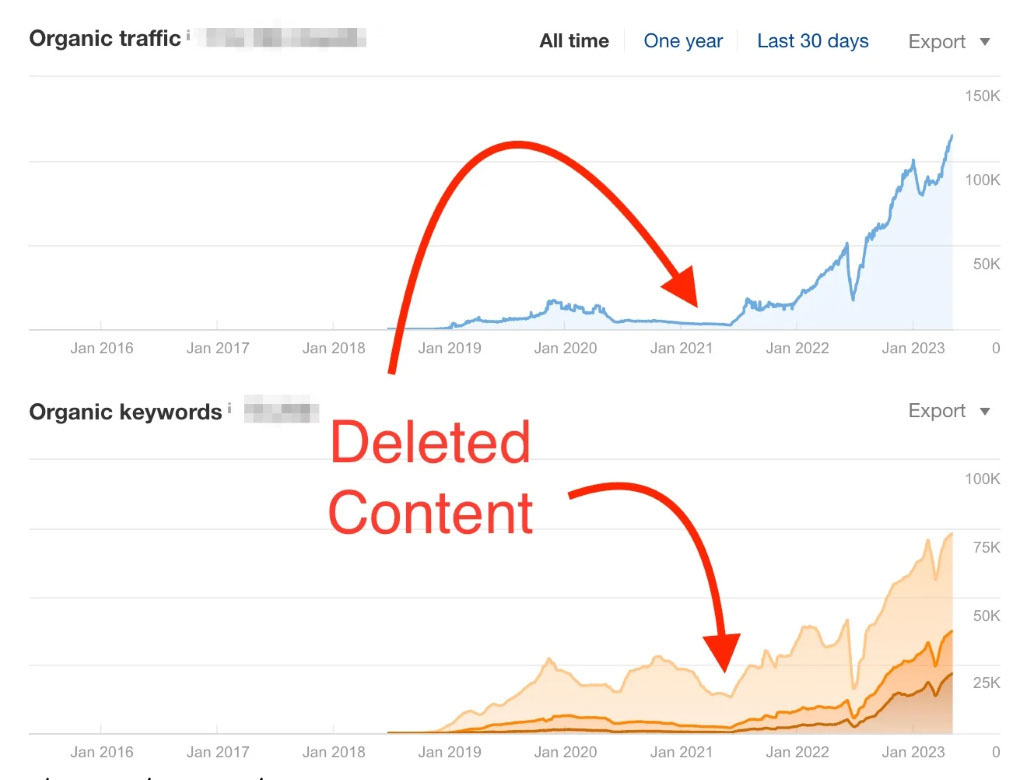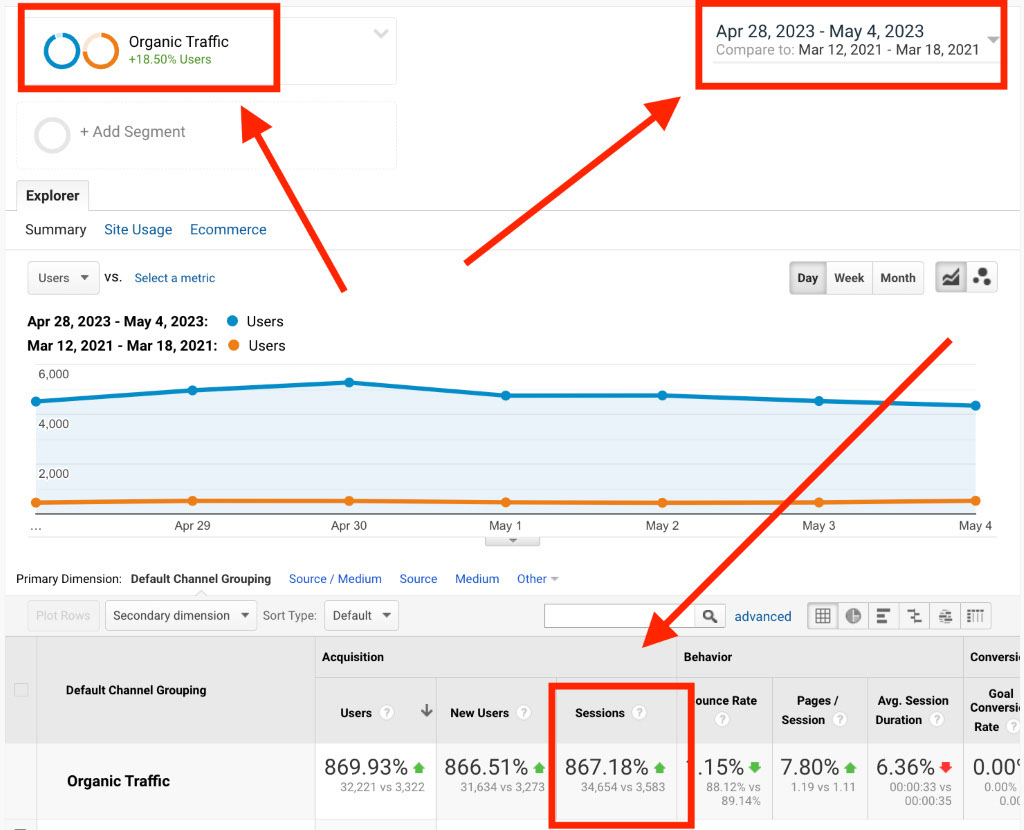Have you ever considered deleting content to boost the SEO performance of your website?

If done right, deleting content in bulk (along with other actions) can lead to explosive growth.
However, it is essential to determine when and what to delete, and when to avoid it.
In this post, I want to share with you several case studies that showcase2 how deleting content silos can significantly impact your site’s performance. Buckle up – its another long one!
When to Delete Content
Low-quality content has been a target of Google’s Panda algorithm since 2011. Google assesses content quality on a page-by-page basis, but the overall quality of your site can be affected by individual articles.
Google’s Gary Illyes and John Mueller have emphasized that low-quality content on one part of your website can impact your entire site’s rankings.
While deleting low-quality content is not a guaranteed solution, it can be an integral part of your strategy to improve content quality and increase topical authority.
For a more in-depth explanation, I recommend reading Glenn Gabe’s article on the subject.
Topical authority, a newer concept, focuses on establishing your website as an expert in a particular subject. Google’s algorithms need to recognize your content as relevant to the topics you claim authority on. Building topical authority can involve:
- Gaining backlinks from authoritative websites in your niche.
- Managing relevance through internal links and anchor text.
- Publishing relevant, in-depth content on your topic.
However, publishing content on multiple topics without establishing authority on each can dilute your website’s overall authority.
While building out rich, in-depth content is ideal, it can be time-consuming and costly. And, updating old content that is not high enough in quality is always a good idea, but is very time consuming and costly as well.
In such cases, deleting content may be a simpler and quicker approach.
Understanding these concepts and taking the right steps will significantly enhance your website’s rankings and authority in the digital marketing space.
| We consult with website’s large and small on whether Deleting Content should be a part of their strategy. Interested in learning more? Take a look at our Website Reviews or Consulting options. |
Website #1
At my agency, 201creative.com we took on an e-com client whose site traffic and sales were flat or slightly declining. The client had added new products and supporting content in the last year, but all product and content traffic was slightly declining.
After we produced our Site Audit and Content Plan, we theorized that expanding into new products/topics had diluted the authority of the site in their original product.
Most of the backlinks to the site were pointing to the first product silo, and most of the previous traffic was going to the first product silo.
This was the best-case scenario for deleting content. We got the support of the brand owners and deleted the newer products and supporting content silos, keeping ONLY the original product and content silo.

The Results
Results were almost immediate (this is rare). Less than two months later, the June 2021 Google Update caused the site to spike in traffic. Keywords fluctuated a lot (we had deleted a lot of content), but traffic skyrocketed. So did sales.
Encouraged, we did more keyword research and started adding a lot of supporting content, along with some minor link building.
One year later, traffic was up 285%, and sales are up 116%.
Over two years later, traffic is up 867% and sales are up 291%.

**Yes, we have continued to work on the site, adding content and building links. No, this is not an argument for deleting content as being a silver bullet. Rather, deleting content, as part of a larger strategy to improve content quality and increase topical authority, makes sense.**
Website #2
The second case study involves a website we purchased in January 2021. After purchase, our initial steps involved a technical site audit and a strategic content plan.
The audit, focused on technical health, site speed, site content, and site links, revealed significant tech debt and a need for vast improvements. The content plan also revealed issues, with content being outdated, thin, and poorly optimized for keywords.
The most significant action was the deletion of a vast amount of content. 3,138 articles were moved to ‘draft’, either being permanently deleted or redirected depending on their backlink status. This comprised over 75% of the website’s content!

A handful of articles were updated and optimized, effectively being completely rewritten for their best ranking keyword, with 54 articles receiving this treatment.
The Results
The results of these actions took time to materialize. There wasn’t much movement for the first year+. No dips, but no gains. We were publishing lots of new content to gain topical authority, but it wasn’t leading to substantial traffic gains.
18 months after the content deletion, the site saw a significant improvement. Organic traffic was up by 108% from the start of the year, and ad revenue had increased, with the site making $5,000 in September 2022.
By December 2022, monthly pageviews almost reached 100k, and revenue peaked at $9,025. This growth continued into Q1 of 2023, with pageviews more than doubling to reach 219,040 by March. Revenue experienced a seasonal dip but started to recover in February and March.

As of May 2023, the average monthly revenue for the past six months was $7,556. Using an average monthly multiplier of 35x-40x, the estimated value of the website was between $264,451 and $302,240, which represents 5-7x growth on its purchase price. We believe that the site could command a higher multiple due to its diversified income streams and reduced risk.
Wrapping Up
Deleting content silos or articles that are not performing can help your site’s performance. Remember that you can always go back and re-publish the content if deleting doesn’t help.
Many site owners expand outside of their site’s “zone” of topical authority. If you are struggling with flat or declining traffic and sales, deleting poorly performing silos might be the right decision for you.
I go into more detail on what situations to delete content in my Search Engine Land article.
Remember that it can take time for Google to understand your “new” site, after you delete content. Sometimes, it can take quite awhile. Reference another case study I shared, where we deleted 75% of a site. It took a year for gains to come.
I hope this case study inspires you to consider deleting content for explosive SEO growth. If you need any help or guidance on this topic, please don’t hesitate to contact me.


Hello Jared, interesting article.
Thank you very much, I deleted some old not ranking outdated posts 🙂
If I may, the “How” in the title is half answered.
May I suggest you to write about the following :
– Should we delete the URLs deleted in the GSC ?
– Should we add a 410 edirection on the deleted URLs ?
Have a nice day mate.